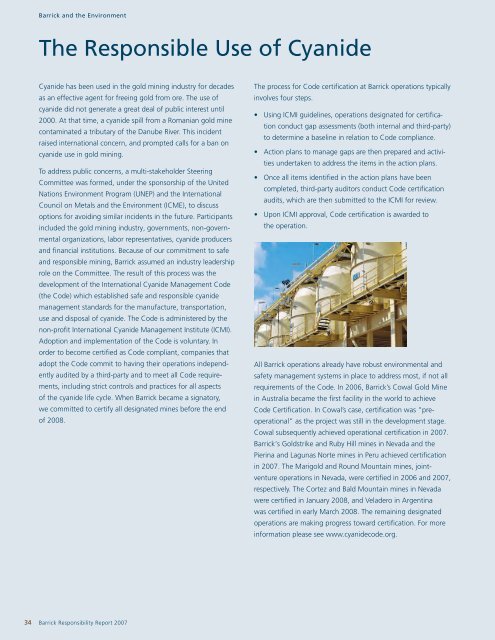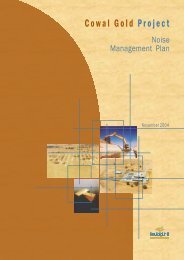2007 Responsibility Report - English (PDF) - Barrick Gold Corporation
2007 Responsibility Report - English (PDF) - Barrick Gold Corporation
2007 Responsibility Report - English (PDF) - Barrick Gold Corporation
- No tags were found...
Create successful ePaper yourself
Turn your PDF publications into a flip-book with our unique Google optimized e-Paper software.
<strong>Barrick</strong> and the EnvironmentThe Responsible Use of CyanideCyanide has been used in the gold mining industry for decadesas an effective agent for freeing gold from ore. The use ofcyanide did not generate a great deal of public interest until2000. At that time, a cyanide spill from a Romanian gold minecontaminated a tributary of the Danube River. This incidentraised international concern, and prompted calls for a ban oncyanide use in gold mining.To address public concerns, a multi-stakeholder SteeringCommittee was formed, under the sponsorship of the UnitedNations Environment Program (UNEP) and the InternationalCouncil on Metals and the Environment (ICME), to discussoptions for avoiding similar incidents in the future. Participantsincluded the gold mining industry‚ governments‚ non-governmentalorganizations‚ labor representatives‚ cyanide producersand financial institutions. Because of our commitment to safeand responsible mining, <strong>Barrick</strong> assumed an industry leadershiprole on the Committee. The result of this process was thedevelopment of the International Cyanide Management Code(the Code) which established safe and responsible cyanidemanagement standards for the manufacture, transportation,use and disposal of cyanide. The Code is administered by thenon-profit International Cyanide Management Institute (ICMI).Adoption and implementation of the Code is voluntary. Inorder to become certified as Code compliant, companies thatadopt the Code commit to having their operations independentlyaudited by a third-party and to meet all Code requirements,including strict controls and practices for all aspectsof the cyanide life cycle. When <strong>Barrick</strong> became a signatory,we committed to certify all designated mines before the endof 2008.The process for Code certification at <strong>Barrick</strong> operations typicallyinvolves four steps.• Using ICMI guidelines, operations designated for certificationconduct gap assessments (both internal and third-party)to determine a baseline in relation to Code compliance.• Action plans to manage gaps are then prepared and activitiesundertaken to address the items in the action plans.• Once all items identified in the action plans have beencompleted, third-party auditors conduct Code certificationaudits, which are then submitted to the ICMI for review.• Upon ICMI approval, Code certification is awarded tothe operation.All <strong>Barrick</strong> operations already have robust environmental andsafety management systems in place to address most, if not allrequirements of the Code. In 2006, <strong>Barrick</strong>’s Cowal <strong>Gold</strong> Minein Australia became the first facility in the world to achieveCode Certification. In Cowal’s case, certification was “preoperational”as the project was still in the development stage.Cowal subsequently achieved operational certification in <strong>2007</strong>.<strong>Barrick</strong>‘s <strong>Gold</strong>strike and Ruby Hill mines in Nevada and thePierina and Lagunas Norte mines in Peru achieved certificationin <strong>2007</strong>. The Marigold and Round Mountain mines, jointventureoperations in Nevada, were certified in 2006 and <strong>2007</strong>,respectively. The Cortez and Bald Mountain mines in Nevadawere certified in January 2008, and Veladero in Argentinawas certified in early March 2008. The remaining designatedoperations are making progress toward certification. For moreinformation please see www.cyanidecode.org.34 <strong>Barrick</strong> <strong>Responsibility</strong> <strong>Report</strong> <strong>2007</strong>
















